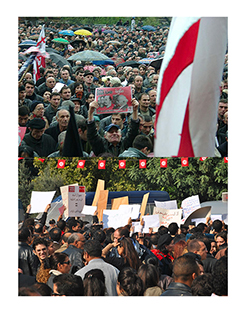Can ‘color revolutions’ and the ‘Arab spring’ be compared?
 Can ‘color revolutions’ and the ‘Arab spring’ be compared?
Can ‘color revolutions’ and the ‘Arab spring’ be compared?
Edited by Anne de Tinguy and Jean-Yves Moisseron
Popular protests have multiplied in East Europe as well as in the Arab world since 1989. East-European revolutions have swept away the European socialist camp in a few months time in 1989. Several “colored” revolutions have broken out in the post soviet space since 2003: the ‘Rose’ revolution in Georgia in 2003 and the “orange” revolution in Ukraine in 2004 lead to change in power; other revolutions have followed in Kirghizstan in 2005 and 2010 and Moldova in 2009 that have revealed the emergence of civil societies in the region. In 2011-12 in Tunisia, Egypt and Libya, “springs” have overthrown authoritarian regimes that had been in power for decades. In 2013-2014, Ukrainians protested against arbitrariness and corruption of power, again. The remarkable recurring aspect of such events suggests a domino effect that questions the observer. The issues that have been raised during the international conference organized in December 2015 with the “Plural Societies” program of Université Sorbonne Paris Cité are addressed in the articles of this dossier. The aim here is to question the mobilizations and transformations in the two neighboring regions of Europe by comparing facts, analyzes and approaches....
Introduction
- Peut-on comparer les ‘révolutions de couleur’ et les ‘printemps arabes’ ?, Anne de Tinguy, Jean-Yves Moisseron
Apport et limites de la comparaison
- Comparer « transitions » postcommunistes et révoltes arabes – Un point de vue semi-sceptique, Jérôme Heurtaux
- Les révolutions de couleur et les printemps arabes chez Francis Fukuyama : mêmes causes, mêmes conséquences ?, Pierre Bourgois
Processus et dynamiques des transformations
- How framing of revolutions (the Arab Spring and Maidan) takes us away from their roots during and after the protests, Nataliya Gumenyuk
- Ukrainian threefold revolution : from Soviet Ukraine to European Ukraine ?, Oleksii Polegkyi
- La grande transformation des pays d’Europe centrale et orientale : tous les chemins (r)évolutionnaires mènent-ils au capitalisme dépendant ?, Eric Magnin
Les acteurs externes
- Le discours néo-impérialiste et néostalinien des ‘conservateurs’ russes autour des ‘révolutions’ ukrainienne et géorgienne’ , -Cécile Vaissié
- La politique de voisinage de l’Union européenne face aux transformations politiques à l’est, Laure Delcour
- Les Etats Unis et l’islam politique. Composer avec les Frères musulmans égyptiens dans les révolutions arabes, Mohamed-Ali Adraoui










